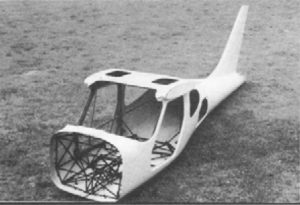 Q. Why metal wings from a company with so much experience with composites?
Q. Why metal wings from a company with so much experience with composites?
A. The design objective’s drove this decision, primarily the low-cost objective, composite’s are all hand made, machines cannot lay cloth plies into molds, (within the price range of kit aircraft). They cannot automatically vacuum bag, trim part’s etc. With aluminum, however, we found that the sheet metal industry has very sophisticated CNC (computer numerically controlled) machines which can stamp, punch, and nibble all the component’s necessary to fabricate wing skins, ribs, spars, brackets, etc. These machines are incredibly fast, accurate, and don’t take breaks or vacations, so they can save quite a bit of money.
Q. Why then, didn’t you follow this philosophy on the fuselage as well?
A. The fuselage is a complex, three-dimensional shape which would be very difficult to manufacture with metal, requiring expensive stretch forming tools. In a general sense, three dimensional shapes beg to be manufactured with reinforced plastics and the flat, two dimensional shapes are more efficiently manufactured out of metal.
Q. Why did you have to use a steel tubular cage inside the fuselage?
A. Actually we didn’t have to, but chose to do it for several reasons. First, it’s easier to build. The fuselage requires less than 20 hours of total laminating, and can be mechanically attached to the steel cage within the span of several more days. An experienced craftsperson could easily have the fuselage joined to the cage on the wheels within one week of work. Secondly, the steel cage also provides an extra measure of crashworthiness. A good insurance premium for the very slight weight penalty it may carry. Third, structural load paths are much easier to calculate and carry with the tubular steel members.
 Q. With such a large baggage area, can a third seat be fitted or a couple of child’s seats?
Q. With such a large baggage area, can a third seat be fitted or a couple of child’s seats?
A. It will be your airplane, you will be the manufacturer, and you can have it your way under the amateur built rules of the experimental category. On the record, we doubt we’ll advertise it as a three place or a two plus two because issues such as rear seat access, comfort, etc. become the focal point of aviation writer’s critiques. We’d rather the GlaStar be recognized as the highest utility two-place than a mediocre three or four place. Off the record though, it doesn’t take much imagination to figure out seating in the back as long as careful attention is paid to passenger restraint systems.
Initial center of gravity and weight statement calculations indicated the GlaStar’s baggage capacity could be as much as 250 pounds.
Q. Can the GlaStar be configured with conventional (taildragger) gear?
A. Absolutely! The tubular steel cage has gear sockets for both tricycle and conventional landing gear.
Q. Can floats be installed?
A. The aft gear sockets will be used for the rear float attach points and the firewall/lower engine mounts will be used as the forward attach point. Every GlaStar airframe will have a 3/8″ thick spacer between the engine mount lower points and the fuselage cage. At any future time, the spacer can be easily removed and replaced with the forward float attach fittings.
Tooling for fiberglass floats is in the final stages for the GlaStar. We hope to be testing the GlaStar on floats sometime in 1995.
Q. Which engine does the GlaStar use?
A. We have developed the aircraft around the Teledyne Continental IO 240. This engine is essentially built from the 0-200 case and 0-360 cylinders and provides 125 horsepower. Continental plans to slightly revise the intake manifold, with the hope that, located further from the exhaust muffler, cooler intake air should raise the horsepower slightly.
Q. Can I put a bigger engine on?
A. In order to attain the impressive baggage capacity, the GlaStar when empty, leans as far forward on the C.G. as possible. Although this provides generous utility, it restricts the ability to install heavier power plants.
We will investigate other power plants in order to get more horsepower especially for use on floats. We are told the Subaru Legacy engine might deliver 150-160 HP on nearly the same weight. Lycoming O-320 150-160 HP engines may also be a possibility if some weight is added to the tail.
Q. When will the kits be available for delivery?
A. We are anticipating that the kits could be ready for shipping by spring of 1995.
Now that the GlaStar is safely back in the R&D shop, we are working to prepare the wings and fuselage for structural testing followed by a thorough flight test program. We expect to begin flight test sometime in October, (assuming structural testing proceeds without delays).



